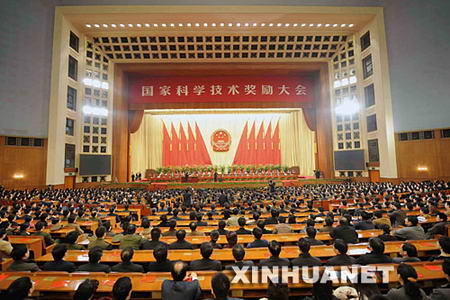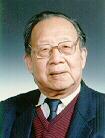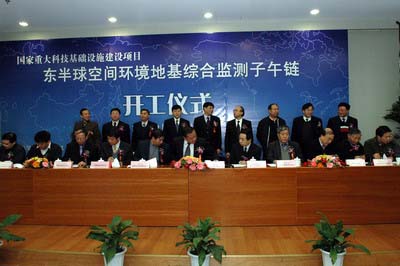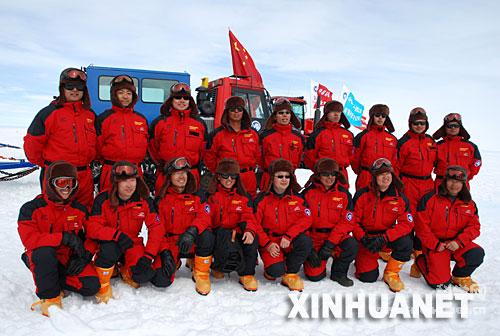|
CHINA SCIENCE AND TECHNOLOGY
NEWSLETTER
The Ministry of Science and Technology
People's Republic of China
|
|
|
N0.498 |
January 10,2008 |
|
|
|
|
|
|
|
|
IN THIS ISSUE
|
|
*07’Top National S&T Prize Honored
*S&T Advancement Law Amended
*Meridian Project for Space Science
*China-India Nanomaterial Cooperation
* China‘s Seismological Observation in Antarctica
*15,000 Ton Hydraulic Press
|
07’Top National S&T Prize Honored

Top National S&T Prize conferred on January 8, 2008 in Beijing

MIN Enze

WU Zhengyi
A national S&T award conferring ceremony was solemnly held on January 8, 2008 in Beijing. Chinese President Hu Jintao personally conferred the Top National S&T Prize to MIN Enze, an academician of both the Chinese Academy of Sciences, and the Chinese Academy of Engineering, and to WU Zhengyi, an academician of the Chinese Academy of Sciences. President HU also presented certificates to other laureates who won the National S&T Advancement Prize, the National Natural Science Prize, the National Technology Invention Prize, and other awards.
In 2007, second-place award of the National Natural Science Prize was conferred to 39 projects, National Technology Invention Prize to 51 projects, of which 1 for first-place award and the other for second-place award. National S&T Advancement Prize had 255 winners, of which 1 for special award, 19 first-place award, and 235 second-place award. Four foreign scientists and one international organization were honored with China International S&T Cooperation Prize.
S&T Advancement Law Amended
Chinese President Hu Jintao singed a decree on December 29, 2007 to make the newly amended S&T Advancement Law be effective from July 1, 2008. The newly amended S&T Advancement Law has 75 articles in 8 chapters under the following titles: general provisions, scientific and technological research, technology development and application of science and technology, industrial technology advancement, science and technology R&D institutes, S&T personnel, support measures, legal obligations, and appendixes. Amendments have been made to reflect the following insights:
1) Make raising the proprietary innovation capacity and building an innovation country part of the law, highlighting the focus of China‘s S&T development strategies, basic principles, and policies.
2) Make formulating and implementing intellectual property strategy, and establishing and perfecting an IP protecting system a mandate for the government, in an attempt to translate S&T findings into productivity in a timely manner, encourage the timely implementation of granted intellectual property, and allow intellectual property to play an important role in spurring up the economic and social development.
3) Enhance investment in S&T activities, through a range of financial, banking, and taxation policies, including establishing special funds, mobilizing all walks of life to enhance investment in S&T activities, and promoting a faster S&T development.
4) Effectively distribute and integrate S&T resources, through a unified and coordinated planning; combine the strength of national S&T experimental bases, establishing an S&T resources sharing system, and allowing S&T resources to play a greater role.
5) Create a new chapter for industrial technology advancement, in an attempt to establish a new technological innovation system with industry as the key player, under the combined strength of industry, universities and research institutes. Industry is encouraged to play a key role in technological innovations, through an array of preferential policies for proprietary innovations.
6) Establish a new incentive system to encourage proprietary innovations, focusing on mobilizing the spontaneity, initiative, and originality of S&T personnel; create an academic environment allowing free explorations, and allowing risk taking, freeing S&T personnel from burdens for taking explorative and risky projects.
The amended law stipulates that S&T personnel who are engaged in explorative and risky projects shall be treated in a benevolent manner, when they fail to reach the desired goals, even with an utmost effort. Meanwhile, the law stipulates that S&T personnel shall boost the spirit of science, observe academic norms, abide by professional ethics, and keep integrity. They shall not fabricate S&T results, nor support or be part of superstitious activities. The amended law also confirms the ownership of intellectual property to the one who undertakes the financed S&T projects.
Meridian Project for Space Science

Signing a data-sharing accord
The Meridian Space Weather Monitoring Project (Meridian Project), led by the Chinese Academy of Sciences, and jointly implemented by Ministry of Education, Ministry of Information Industry, China Earthquake Administration, State Oceanography Bureau, and China Meteorological Administration, made its ground breaking ceremony on January 5, 2008 in Beijing.
The project will work on the meridian space weather along 120°E, through the existing stations in Mohe, Beijing, Wuhan, Hainan, and Antarctic Zhongshan Station, and 15 monitoring sites along 30°N in Shanghai, Wuhan, Chengdu, and Lhasa. It will collect a range of space weather data, including geomagnetic field, electric field, wind field, density, temperature, and elements in the middle and upper atmosphere, troposphere, magnetosphere, interplanetary space, using geomagnetic, radio, optic, upper air sounding, and rocket means, in a range from 20-30km to several hundred kilometers. With a budget of RMB 167 million, the 3-year project will produce three major systems for space environment monitoring, data and telecommunication, and research and prediction.
|
INTERNATIONAL COOPERATION |
China-India Nanomaterial Cooperation
A China-India seminar on developing new materials through nanotechnology, co-sponsored by NSFC and CSIR, and organized by the CAS Institute of Chemistry, was recently convened in Beijing. 15 scientists from Indian research institutes and 20 scientists from Peking University, Tsinghua University, and CAS research institutes attended the meeting. During the meeting, the Indian delegation visited China Nanometer Research Center, Tsinghua University, and CAS Institute of Chemistry.
The seminar is the fourth of its kind since the signing of a summary report for cooperation between NSFC and CSIR in March 2006 for the period of 2006-2008. These seminars have deepened the mutual understanding between the scientists of the two nations, and laid a foundation for substantive cooperation in the future.
China‘s Seismological Observation in Antarctica

Team photo of China‘s 24th Antarctic Expedition
17 members of China‘s 24th Antarctic Expedition Team kicked off their trip on December 22, 2007, heading for the Amery Ice Shelf, the top inland ice cover of the Antarctica, with an elevation of 4093m above sea level. On January 4, 2008, the expedition team has installed a low temperature wide-band seismograph in a site near the Xiongying camp 806 km away from China’s Antarctic Zhongshan Station, the first of its kind deployed by Chinese in the region. 500m away from the Xiongying camp where team members are dwelling, the installation site is free from human noise. A second seismograph will soon be installed in the back of the Amery Ice Shelf, at an elevation of 4093m.
Seismological observation in the Antarctic inland will help scientists to understand the crust and inner structures of the continent, which will eventually help people to understand the continent’s plate tectonics and inner dynamics.
Space Tobacco into 6th Generation
In the greenhouse of Shanghai Institute of Plant Physiology and Ecology, part of the Chinese Academy of Sciences, the 6th generation of space tobacco has grown for 60 days, with a straight stalk of 60-70cm topped with pink flowers. In the past 5 years, researchers have kept a watch of the changing traits of space tobacco in different generations, and have observed mutations of both leaves and flowers in different combinations. Study results show that cell fusion activities are stronger in space than on the ground, with 53.1% for the one in space, and 38% for the one on the ground. Meanwhile, cells’ metabolism also saw significant changes.
The space tobacco study has enhanced the development of China’s space biotechnology, creating a mature technical roadmap for plant somatic cell fusion, and providing scientific evidences for breeding other high yield and diseases resistant crops, including wheat, corn, and soybean in a space environment.
16 Amino Acids Inhibit HIV Infection
A study team, headed by Prof. WU Zhiwei of Nanjing University Medical School, has recently identified a special functional unit for HIV resistant protein gp-340, and believed that the area made up of 16 amino acids is associated with HIV infections.
Researchers found in a study of saliva that one’s mouth usually does not allow active HIV viruses, as the result of existence of a number of active proteins that are resistant to HIV infections, especially a protein called gp-340. gp-340 is supposed to play two important roles in human body: for the development and division of cells, and for natural immunity. These two traits are consistent with the activity of gp-340 in inhibiting HIV infections.
In the early 2007, Prof. WU and his team have narrowed down the specific functional unit for HIV resistant active proteins to 1/10, and sorted out 16 amino acids from 107 candidates for their roles in inhibiting HIV infections.
Robot for Grinding and Polishing
Not long ago, Shenyang Xinsong Robot has rolled out a robot system able to do grinding and polishing jobs. It can be widely used to process or repair parts and components, including the transparent part of the cockpit, molds, and blades.
Made up of a mechanic body, high precision service roundtable, control system, and thickness test system, the 5-axis robot system is able to perform high quality, and high precision grinding or polishing jobs on components or parts of different sizes, for desired thickness and moment.
Equipped with a range of advanced technologies, including visual measurement and positioning, and high precision wrist sensing, the robot system is able to work on 3-D transparent objects according to external shape, ensuring a precise repetition between reconstructed curve and the dynamic mechanism. A multi-CPU configuration with two different programming modes is used to ensure the reliability of the entire system. The system can be controlled either in a point-to-point manner, or in a continuous manner, allowing real time display of coordinates, joints, measurements, and calculation of attitudes and errors.
Proprietary Laser Display Technology
WANG Yu, Vice President of CAS Academy of Opto-Electronics, told the audiences attending a seminar on optoelectronics and cutting edge development, that the Academy has worked out digital laser displays of different sizes ranging from 100m2 for movie screen to 55-inch for TV display. The proprietary laser display technology developed by Chinese researchers has a core component that can be a match to the similar products manufactured by advanced countries such as Japan.
WANG said China has chosen a unique road for developing optoelectronics on its own. It has done more than topping the laser display technology in the world. For example, its laser altimeter, a payload aboard the Chang’e I lunar satellite, has played an important role in the moon probe.
He added that laser display technology undoubtedly bring up a revolution to the display industry. Thanks to the accelerated R&D efforts of major manufacturers, laser display products will be seen on the market around 2010.
15,000 Ton Hydraulic Press
China No. 1 Heavy Duty Machinery Group has recently developed a proprietary 15000-ton hydraulic press, the largest and most advanced of its kind in the world. The successful operation of the hydraulic press makes China the third country in the world possessing a 15000-ton hydraulic press.
The gigantic press is designed with a horizontal pre-stress framework, and 16-facet readjustable horizontal navigation structure. It is also for the first time equipped with a huge box shaped upper beam and active beams. These technological innovations have made the Chinese made hydraulic press the most advanced in the world. Test results show the press has reached an engineering press of 15,000 tons, with a net height of 8m, and open width 7m, and maximum active beam range 4m. It has also achieved a laudable precision in both forging and control.
Peking University’s Science Database
Peking University opened on December 28, 2007 “Century of Science”, the first campus science database in the country. One can search some 850,000 scientific and reference books published during the period of 1900-1944 both at home and abroad, and associated citation information.
ZHU Qiang, deputy head of the Peking University Library said that the operation of Century of Science has opened up a gate leading to a century old science treasuries for people both at home and abroad, allowing them to track down the scientific development in the century. The century old scientific literature may help people to define the direction of future studies, and help them to complete their current studies. The new database will allow Peking University to have a higher, deeper, and more extensive collaboration with the world science community, promoting China’s proprietary innovations. ZHU added that the database would provide data search service for the users both at Peking University and other universities.
Comments or inquiries on editorial matters or Newsletter content should be directed to:
Mr. XU Chaoqian, Department of International Cooperation, MOST 15B, Fuxing Road, Beijing 100862, PR China Tel: (8610)58881360 Fax: (8610) 58881364
http://www.most.gov.cn | 
